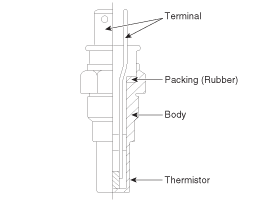 Kia Sportage: CVVT Oil Temperature Sensor (OTS): Description and Operation
Kia Sportage: CVVT Oil Temperature Sensor (OTS): Description and Operation
Third generation SL (2010ŌĆō2016) / Kia Sportage SL Service & Repair Manual / Engine Control / Fuel System / Engine Control System / CVVT Oil Temperature Sensor (OTS): Description and Operation
| Description |
Continuous Variable Valve Timing (CVVT) system advances or
retards the valve timing of the intake and exhaust valve in accordance
with the ECM control signal which is calculated by the engine speed and
load.
By controlling CVVT, the valve over-lap or under-lap occurs,
which makes better fuel economy and reduces exhaust gases (NOx, HC) and
improves engine performance through reduction of pumping loss, internal
EGR effect, improvement of combustion stability, improvement of
volumetric efficiency, and increase of expansion work.
This system consist of
- the CVVT Oil Control Valve (OCV) which supplies the engine
oil to the cam phaser or runs out the engine oil from the cam phaser in
accordance with the ECM PWM (Pulse With Modulation) control signal,
- the CVVT Oil Temperature Sensor (OTS) which measures the engine oil temperature,
- and the Cam Phaser which varies the cam phase by using the hydraulic force of the engine oil.
The engine oil getting out of the CVVT oil control valve
varies the cam phase in the direction (Intake Advance/Exhaust Retard) or
opposite direction (Intake Retard/Exhaust Advance) of the engine
rotation by rotating the rotor connected with the camshaft inside the
cam phaser.

 Rail Pressure Sensor (RPS): Repair procedures
Rail Pressure Sensor (RPS): Repair procedures
Inspection
1.
Connect the GDS on the Data Link Connector (DLC).
2.
Measure the output voltage of the RPS at idle and various engine speed.
ConditionOutput Voltage (V)Idle Approx. 1.21, ...
 CVVT Oil Temperature Sensor (OTS): Specifications
CVVT Oil Temperature Sensor (OTS): Specifications
Specification
Temperature [┬░C(┬░F)]Resistance (k?)-40(-40)52.15-20(-4)16.520(32)6.020(68)2.4540(104)1.1160(140)0.5480(176)0.29
...
Other Information:
Crash Pad: Components and Components Location
Components
1. Main crash pad assembly2. Crash pad side cover [LH]3. Crash pad side cover [RH]4. Cluster fascia panel5. Reinforcing panel6. Crash pad lower panel7. Center facia panel8. Crash pad g ...
Engine Coolant Temperature Sensor (ECTS): Specifications
Specification
TemperatureResistance (k?)┬░C┬░F-40-4048.14-20-414.13 ~ 16.830325.7920682.31 ~ 2.59401041.15601400.59801760.32
...
Categories
- Home
- Kia Sportage QL (2015-2019) Owners Manual
- Kia Sportage QL (2015-2019) Service Manual
- Kia Sportage SL 2010-2016 Owners Manual
- Kia Sportage SL 2010-2016 Service Manual
Copyright ® www.kispmanual.com 2014-2025
